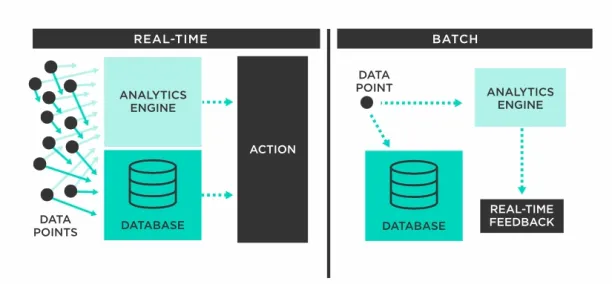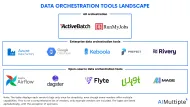40+ Best Batch Processing Applications You Must Know in 2024
According to big data statistics, 90% of business leaders consider data and analytics as key to their organization’s digital transformation. Yet, they can only use 12% of their data. Such stark differences between goals and current capabilities exist in numerous tech domains and batch processing can help close these gaps.
Automated batch processing is a method for organizations to collect, store and process large amounts of data and transactions in batches simultaneously and continuously with no or little human intervention (See Figure 1).
Business executives must be aware of batch processing applications to identify similar use cases in their organizations. Therefore, we gathered the most common 41 batch processing applications and assigned them to 11 categories (e.g. general processes, sales, finance, customer service management, and industry-specific industries).

General batch processing applications
1. Data Processing: Batch processing can process large volumes of data in batches. Some examples of data processing are data cleansing, aggregation, and transformation.
2. Report Generation: Batch processing can analyze and summarize data to create reports for financial, operational or performance reporting.
3. Backup and Recovery: Batch processing can ensure data integrity and availability by applying backup scheduling, backup file management, and data restoration.
4. Batch Job Scheduling: Batch job scheduling is another type of batch processing application that can schedule and run a series of batch jobs (e.eg. monitoring and execution) automatically.
5. Integration and Interoperability: Batch processing can help with integration and interoperability between different systems and applications through data exchange, synchronization, and integration.
Applications in Business Functions
Sales
6. Lead Management: Leads can be enriched with other data sources and prioritized in batches before the start of the day for sales personnel. This way, the sales team can save time by focusing on high-value leads first.
7. Sales Reporting: Sales reporting involves analyzing sales data to gain insights into the sales process. Batch processing can automate sales reporting, allowing sales teams to quickly and accurately analyze big data.
8. Order Processing: Sales teams can use batch processing to manage the order fulfillment process, track inventory levels, and manage customer information faster and more accurately.
9. Campaign Management: Batch processing can help manage sales campaigns by analyzing large numbers of leads or prospects in batches. As a result, sales reps can focus on specific segments or groups.
10. Customer intelligence: Batch processing can investigate sales data to identify customer behavior, buying patterns, and trends.
Marketing
11. Email Marketing: Batch processing can seamlessly send large volumes of emails to a list of subscribers in batches, ensuring quick and efficient delivery of emails.
12. Ad Campaigns: Batch processing can enable marketing teams to optimize their campaigns by processing ads in batches and tracking their performance.
13. Social Media Marketing: Batch processing can be useful for social media marketing since it can schedule and publish posts on social media platforms. This way, marketers can save time and ensure that posts are published consistently.
14. Marketing analytics: Batch processing can provide insights on customer behavior, engagement, and ROI by fastening the analysis and segmentation of customer data, leads and campaign data.
Finance
15. End-of-day processing: Financial services companies can leverage batch processing to automatically and accurately perform end-of-day processing to reconcile transactions, generate reports, and other tasks.
16. Fraud detection: Batch processing can detect fraudulent transactions by analyzing large volumes of data and identifying patterns and anomalies.
17. Risk management: Batch processing can help the finance sector identify and mitigate risk in a more data-driven way by analyzing data and identifying potential risks.
18. Compliance: Batch automation can simplify complying with regulatory requirements for financial services companies by automating compliance tasks and ensuring the consistency and accuracy of the data.
IT processes
19. System Monitoring: Batch processing can allow teams to process system logs, event data, and metrics to detect and resolve issues quickly.
20. Reducing manual activities: With batch processing, IT teams can schedule and automate recurring tasks, such as database backups, patching, and system maintenance. This way, IT organizations can save time for more value-added tasks and ensure that critical tasks are completed on time.
21. Resource management: Batch processing allows IT teams to manage server resources, allocate memory and disk space, or optimize database performance.
22. Optimize costs: With batch processing, IT organizations can reduce the costs allocated for expensive hardware or infrastructure, saving on operational costs by running jobs during off-peak hours.
Customer service
23. Ticket Management: Another batch processing application is the management of high volumes of service requests, incidents, and changes. Therefore, IT teams can prioritize and handle tickets more efficiently.
24. Data management: Batch processing can ensure data integrity and efficiency by backing, archiving and transforming the company data.
25. Feedback Management: With batch processing, customer service teams can process and analyze customer feedback in batches, such as surveys and reviews, to identify trends and issues more efficiently.
Logistics
26. Order Processing: Batch processing can help logistics teams handle orders more efficiently by autımatically fulfilling a large volume of orders.
27. Inventory Management: Batch processing can manage inventory by automatically tracking stock levels, shipments, and other information.
28. Shipping and Tracking: Batch processing can ease the processing and tracking of a large volume of shipments and delivery information, improving the accuracy of the information shared with customers.
29. Improved performance: With batch processing, logistics teams can improve supply chain performance, demand forecasting, and operational efficiency.
Retail
30. Promotions and Discounts: Batch processing can allow retailers to apply discounts to a large volume of products by processing data in batches.
Telecom
31. Billing and Payment Processing: Batch processing can ensure telecom companies process and manage billing and payment more efficiently.
32. Managing Call Detail Records (CDR): With batch processing, telecom companies can process and manage a large volume of call data, such as call duration, location, and usage.
33. Network Traffic Analysis: Batch processing can analyze large volumes of network traffic data to gain insights into network performance, traffic patterns, and usage.
34. Detecting fraud: Batch processing can help in fraud detection, such as call spoofing or SIM cloning.
Healthcare
35. Electronic Health Records (EHR) management: Batch processing can help process and manage electronic health records (EHR), including patient records, lab results, and clinical notes.
36. Improving Medical billing: Batch processing helps improve billing accuracy by automatically processing and submitting medical bills to insurance companies or patients.
37. Easy patient care & diagnosis: Batch processing can optimize patient care and diagnosis by analyzing large volumes of patient data, such as medical history, demographics, and clinical outcomes.
Education
38. Student Records: Automated batch processing can be useful to manage student records, such as admissions, enrollment, grades, and transcripts, more efficiently.
39. Course Management: Batch processing can allow educational institutions to manage courses and course-related data, such as course schedules, assignments, and exams.
40. Financial Aid Processing: Another batch processing application is streamlining financial aid management where educational institutions can manage financial aid, such as scholarships, grants, and loans, more efficiently and with fewer errors.
41. Using educational data: Educational institutions can leverage batch processing to analyze data and gain insights into student performance, attendance, and behavior.
Further reading
Explore more on batch automation and workload automation by checking out:
If you believe your organization can benefit from automated batch processing or other workload automation tools, use our data-driven and comprehensive list of WLA vendors.
External Links
- 1. “What is Batch Processing?” TIBCO. Revisited April 27, 2023.



Comments
Your email address will not be published. All fields are required.